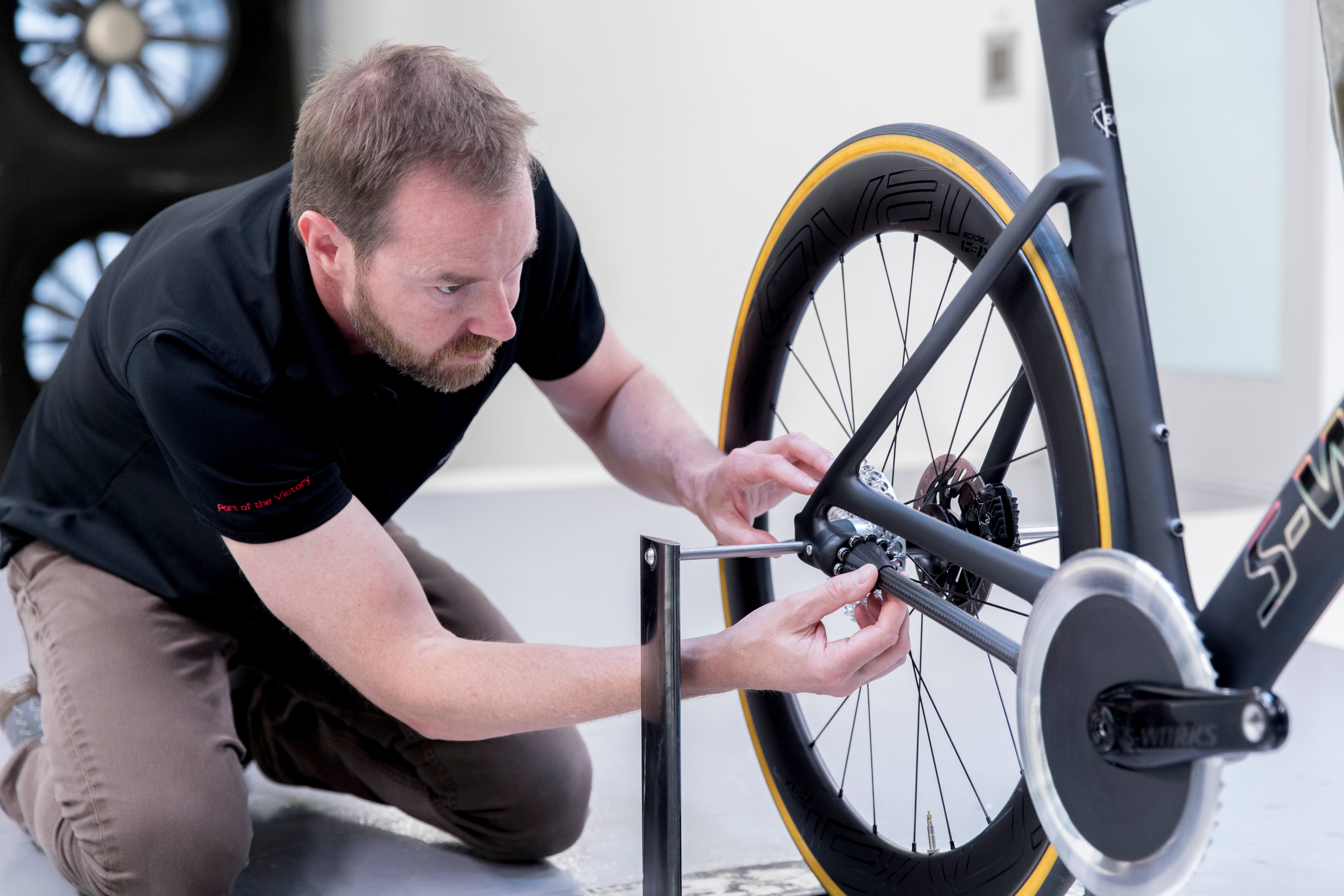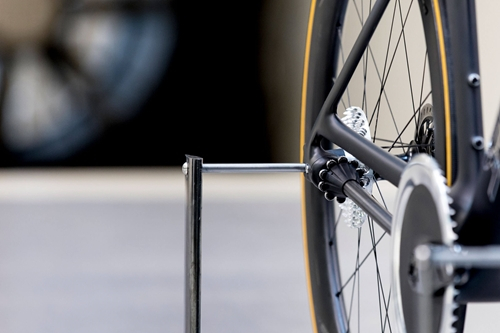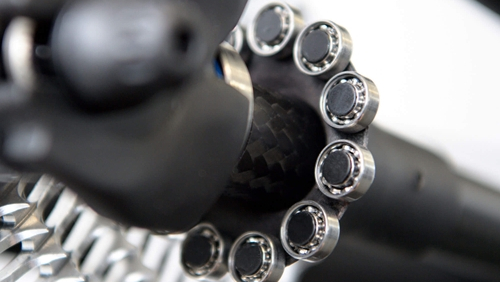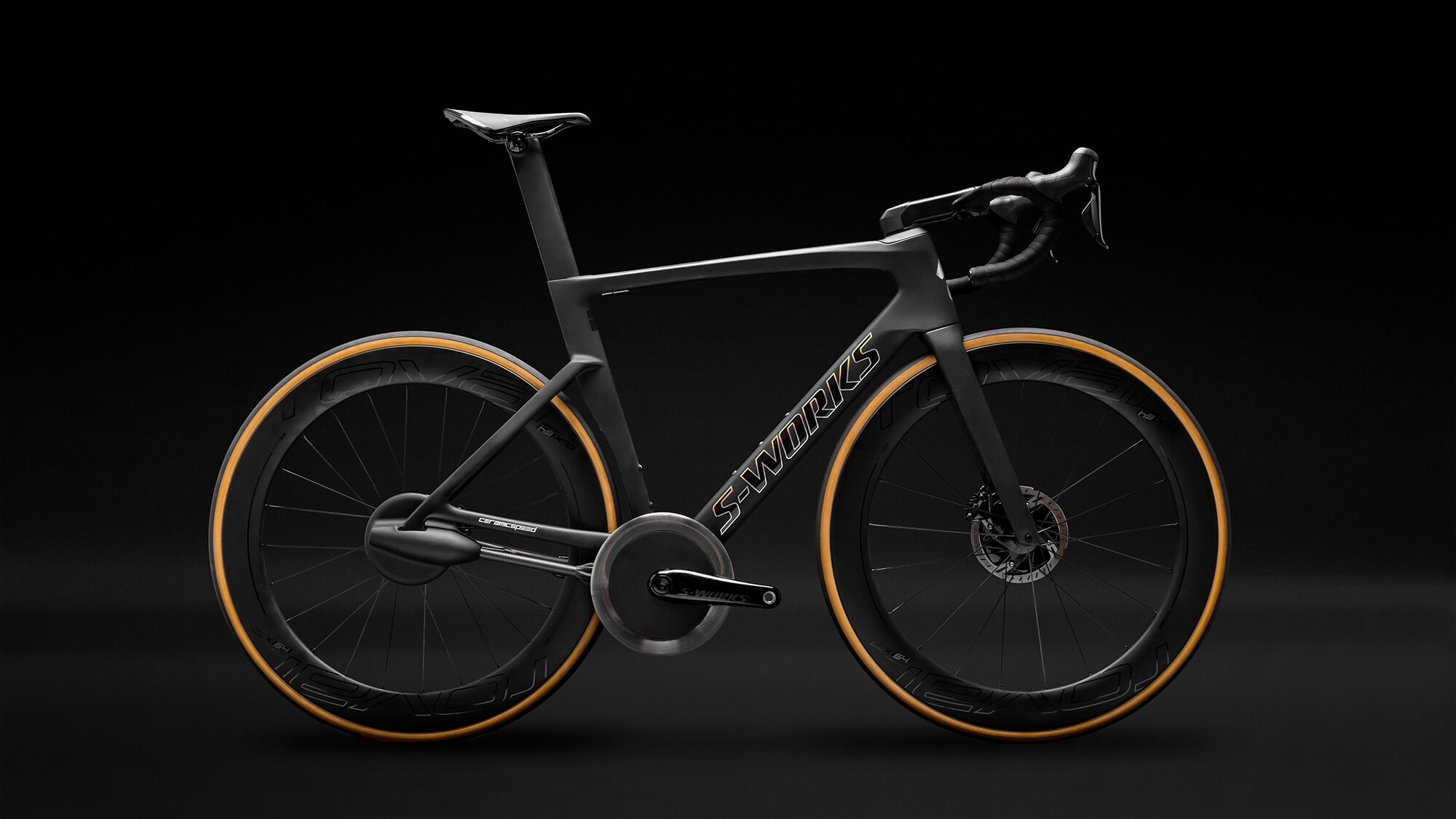CeramicSpeed Driven: An exclusive interview with inventor and CEO, Jason Smith
There's still hope for the futuristic chainless drivetrain concept, which has become the first project of newly formed CeramicSpeed offshoot company, Driven Technologies Inc

CeramicSpeed today announced that it's futuristic chainless drivetrain concept, Driven, will formally split from the company to become a business entity in itself.
In a move that comes primarily from a desire to raise capital, one-third the of newly formed company, Driven Technologies Inc, is being made available to investors via equity crowdfunding platform, SeedInvest, and is open to anyone willing to stump up the minimum $1,000 investment.
The concept and technology was pioneered by CeramicSpeed CTO, Jason Smith, and his team out of the brand's R&D facility in Boulder, Colorado, and has been in development as a 'skunkworks' project since 2017.
Ahead of the announcement on Monday, Cyclingnews spoke with Smith, who becomes the CEO of Driven Technologies Inc in an exclusive interview discussing the details of the investment opportunity, how the product has developed since its last public appearance in 2019, and the company's plans for the future, including where the funds will be spent and Smith's lofty goal - his own admission - of getting it into the WorldTour next year.
Cyclingnews: Jason, please give us a brief background on your career.
Jason Smith: I'm Jason Smith. Presently, I'm Chief Technical Officer of CeramicSpeed. I have a mechanical engineering degree from Pennsylvania State University here in the States, with a focus on mechanical ceramics, which helps a lot with working for CeramicSpeed. I've always been an avid cyclist and used to be a big triathlete on-road and off-road with Xterra, back in the late 2000s when it was having its heyday.
In 2012, I started a company called Friction Facts, which was the world's first independent lab for drivetrain efficiency testing. And what that did was it essentially took a big factor out of the marketing BS that was being put out of the companies at the time. We did a lot of lube testing, drivetrain articles and a lot of testing from 2012 to 2016. We invented the optimised race chain, Friction Facts was the first to sell a chain that had been fully optimised.
Get The Leadout Newsletter
The latest race content, interviews, features, reviews and expert buying guides, direct to your inbox!
In 2016, CeramicSpeed acquired the Friction Facts brand, the test lab, and all of the equipment. So I came on board with CeramicSpeed and became the CTO.
CeramicSpeed is based in Denmark, and we're located in an R&D lab here in Boulder. So the Denmark operation, including the R&D is a lot larger, but what we do over here in America is with respect to R&D is a lot of the skunkworks projects and other projects that are riskier, and might have a two or three year potential lead time before they'd be ready for primetime in the market.
Driven came about as a skunkworks project when we did the pursuit of the one per cent drivetrain campaign back in '17, and it was kind of a fact-finding mission, but it was really set up as let's just see what we can do.
CN: So in more detail, could you explain exactly what Driven is, and how it differs from a conventional drivetrain?
JS: Driven is a revolutionary drivetrain platform, that can be applied to time-trial road, commuter bikes, traditional bikes, e-bikes. And essentially, instead of a chain and rear derailleur style traditional drivetrain, it's a geared system that uses a shaft drive so there's no exposed chain. Power transfer occurs through the driveshaft and it's a full multi-gear system. The magic behind it, which is the patented portion of Driven is that it doesn't use traditional gear teeth.

Shaft drives have been around for 100 years for bicycles, but they are all bevel gears, for the most part. Those are heavy and very, very inefficient and that's one of the reasons you don't see traditional shaft drives on bicycles more. So what we invented was essentially exchanging one of the big set of gear teeth for ceramic bearings. So these bearings transfer the power from the front pinion into bearings, and then through the driveshaft, and then from bearings into the rear cassette, the flat cassette / cog.
So to wrap it all up, the patented magic with the efficiency is that we're removing all sliding friction from the drivetrain and replacing it with rolling elements, which are much, much more friction free than sliding elements.

We also have a patent pending on the shifting technology which is pretty innovative, and all of the wireless and the electronics and the shifting mechanism. It's all located enclosed inside of the drive shaft and there's no rear derailleur hanging down.
CN: How is this better than a conventional drivetrain?
JS: Firstly, it's going to be more aerodynamic - we proved that in the Specialized wind tunnel - because we're moving the chain and the rear derailleur and all that mechanism that's hanging down; it's tucked in a lot cleaner. It's also lighter weight; comparable, I think it's around 15 per cent lighter - I don't have the numbers in front of me - than a comparable chain style drivetrain. It's more cost-effective. Not so much right now making a one-off, but with economies of scale, there are very few moving parts in the system; we don't have the chain, we don't have the wide cassette with multiple cogs, it's very clean and simple, so the cost is projected to be lower than a traditional drivetrain. And it can be enclosed, which is very important for maintenance. A traditional rear derailleur drivetrain has the rear derailleur hanging down so it's, it's very, very difficult, if not impossible, to enclose that.
But one thing that's super important is when you look at the rear of a typical bicycle, the way everything is positioned and the spoke patterns too, are all dictated by the drivetrain. I don't want to spill the beans on development here, but let's say that by using something like Driven, where the freehub function can be in the driveshaft and not in the rear hub. It completely opens up the real estate of that rear hub area. Our cassette is relatively flat, meaning it's not wide like a traditional cassette and can be placed more inward in the rear hub assembly. So now with the cog assembly spinning in sync with the rear wheel, it's actually mated to the rear wheel and can actually become part of the hub assembly.
There's a lot of potential for this technology to really change the whole rear end of a bicycle including the entire rear wheel can be thought of differently when you remove these restrictions that are placed on a rear wheel by the traditional drivetrain.

CN: On the subject of development, since Driven's last public announcement - the unveiling of working shiftable and rideable prototypes at Eurobike 2019 - how has Driven developed?
JS: At Eurobike, we had the rideable version under limited load and we had the shiftable version. Ultimately, we wanted to develop these together so that we get full rider load, fast shifting, and make them into one drivetrain.
When we came back from Eurobike we did some basic development on strengthening the driveshaft, miniaturisation of electronics, the battery, developed some concepts for faster shifting and really started looking at some of these ideas for really revolutionary design for a new rear wheel. But nothing newsworthy, and no goals were met at that point.
This kind of segues into the reason that we're fundraising today. We made a decision internally that we wanted to look for external funding, we slowed development down and I took the lead on fundraising. Then just as we're about to get that started, COVID [happened]. I had my first venture capitalist meeting set up and had the bikes ready to go in Boulder and then that specific week, everything just shut down in Colorado, so development and fundraising of Driven were put on hold.
In the last couple of months, we've reignited the fundraising efforts which leads us to the opportunity that is here right now. After today, when all the projects get transferred and we get funding for Driven Technologies, it's going to be full gas moving it forward.
CN: I'm not going to pretend that I'm an expert in investment, so please explain how that's set up.
JS: So the first thing that's important to know is this is what's called an equity crowdfunding campaign. And I put a lot of emphasis on the word equity because it's completely different from a traditional crowdfunding campaign like Kickstarter. With a traditional crowdfunding campaign, an investor isn't investing in the company, they're purchasing a product or purchasing an incentive. They're giving the company money and get something in return, but it's not a piece of equity in the company.
Through equity crowdfunding, anyone can invest. So you don't have to be uber-wealthy or make a million dollars a year and check these boxes to become an accredited investor. Through equity crowdfunding platforms, anyone can invest in companies and get the same benefits and rights. In the case of Driven Technologies, an investor will be able to own a piece of Driven.
SeedInvest, the platform that is hosting this, is arguably the most reputable equity crowdfunding platform in the United States. It only accepts one per cent of applicants that come in, so when we chose SeedInvest, we did so because of their vetting, their reputation and their success with startups. It was a very difficult process for the due diligence to go through, but we were accepted, which is a proud moment for us at Driven Technologies. So when you go on to SeedInvest and invest, all the back work has been done. We've been through that process so the investor can have confidence that all the paperwork, the SEC [Securities and Exchange Commission] regulations and the contracts are all done in the background.
The investment opportunity is going to be what's called a convertible note. In a nutshell, there's going to be a valuation of the company, and let's say it's $5 million. So whenever an investor puts in, say, $50,000, to make the math simple, they own one per cent of the company. That convertible note will convert to equity. So let's say in three years, when we hit $10 million, hopefully, that investor's money will triple.
I have to be cautious here because there's a lot of SEC regulations that go on. So I'll leave it at that, and the SeedInvest site has a lot more of the terms and conditions of the purchase equity purchase.
CN: How would one go about investing?
JS: Anybody that's interested in checking out the opportunity can go to SeedInvest and create an account. Everything is in there, as well as an open discussion board, which is important as we're offering this to the fans of Driven that might not be investors. If a potential investor asks a question, I'll reply, but everybody will be able to see it.
Then, if somebody chooses to purchase, they essentially click 'buy now' and they'll be asked what per cent of the company would they like to own? It's as simple as that, and go ahead and make the purchase.
CN: And the minimum investment required?
JS: Per the SeedInvest site, the minimum is $1,000.00
CN: So how is Driven's position within CeramicSpeed affected?
JS: We set up Driven Technologies Inc so the investor could be sure that CeramicSpeed is not going to take their investment in Driven, and start pumping it into somewhere else.
What we decided was that we really wanted to break it away, because it's not a core product of CeramicSpeed. That way, my team can focus on the development of just Driven as up to this point, we're still CeramicSpeed so we've had a bunch of different projects that we work on alongside Driven. This will allow this team to focus on the Driven system alone.
But also it facilitates the opportunity for investment. By creating Driven Technologies Inc, everything Driven - the patents, the prototype bikes, any intellectual property at all - has already been transferred over into Driven Technologies. This was a lot of the work that's been done the last few months with SeedInvest, to set all this up.
It's really a win-win situation for Driven Technologies because, from a business entity standpoint, we are our own company; everything business-wise is completely different, people-wise and technology-wise, too. We're moving to a new facility, as we've outgrown the CeramicSpeed office here. So within six weeks, Driven Technologies will have its own facility in Boulder, Colorado, so it's a physical separation.
However, one of the things that will be advantageous to Driven Technologies is that we'll still be able to utilise the resources of CeramicSpeed. Even though Driven is its own business entity, the owners of CeramicSpeed are also the majority owners of Driven Technologies, so it's in the interest of CeramicSpeed for both companies to be successful.
CN: So with that, has the valuation been made of Driven Technologies, and how much is effectively for sale?
I'll put the disclaimer on this to please go into the SeedInvest site where all this is listed.
Editors note: According to the SeedInvest website, the valuation cap with a convertible note is $3.3 million. For the Driven investment, this includes a 10-per cent incentive for the first two weeks. Driven has authorised $1 million worth of fundraising, which equates to one-third of Driven Technologies on the market for sale, and after 60 days, the campaign will stop if it hasn't hit that million dollars.
CN: You're trying to raise funds for a purpose. What is that purpose? Where does the money go?
JS: So the first six months will be 100 per cent development of the product of the drivetrain itself. So the use-of-funds will be for R&D for the engineering team, to strengthen the drivetrain, to get the shifting dialled in, and to meet everything.
We have a clear vision of where we want to get Driven within six to 12 months. However, the getting there is a decent amount of work because we've got to make the system bulletproof.
The next step is we're most likely going to make a fleet of bikes to get the drivetrain out there. Possibly put it under a couple of professional athletes for some races, if we can get a few wins with his bike, that'll really take things off. We're not sure on this decision yet, but we might also make limited edition Driven bikes for maybe 25 bikes, kind of an exclusive one time deal.
And then for the third six months, which leads up to that 12 to 18-month timeframe, we'll work on manufacturing, cultivating the OEM relationships, pending on the outcome of the bikes' success up to that point, that will drive the commercialisation, marketability and marketing of the drivetrain to OEMs. So after the first R&D, as far as the use-of-funds is concerned, then we get into potentially building some bikes, hiring strategic marketing personnel and branching it out.
CN: How far away is Driven, in your opinion, from being on a bike that I can go to a shop and buy?
JS: I'd say two to three years if we track on target next season. Essentially a year from now - summer of 2022 - we'd like to have bikes, not for sale per se, maybe those limited editions, but we'd like to have bikes out there. The manufacturing will start gearing up for that 18-month timeframe.
CN: What sort of bike is that likely to be?
JS: Ultimately, we envision anywhere there's a chain, this could ultimately replace it, which means performance right down to entry-level. The plan is to go the performance route, but also on the side, look at fleet bikes and e-bikes. The reason for that is we're very familiar with the performance side and it makes a big splash in the media and we'd get headlines if we got a couple of pro race wins. However, in order to take Driven where we really want to, we can't rely on just the high end $15,000 bike market. It's a cost-effective system, so it also makes sense on commuter bikes, but it's much more difficult to jump into OEM, commuter, leisure, e-bikes, fleet bikes, etc with a new product without a proven concept and the media and public demand behind it.
CN: Will there be tiered pricing, similar to how Shimano has 105, Ultegra, Dura-Ace?
JS: No, instead of tiers, we'll probably have two different designs. For the performance aspect, it will be much higher efficiency, a lot lighter. Everything that a racer is looking for. When we get down to say, the commuter area, it might not have the efficiency, it might have different benefits.
CN: Clearly with the prototypes you had at Eurobike 2019, there's some interest from those brands to see where this can go. Are those conversations and relationships still ongoing? Do you have any more in the pipeline?
JS: I can't name names, but OEMs love Driven, they want to see it on their bikes. However, we need to get it to the next bulletproof stage. We're working and communicating with them, but they aren't gonna pull the trigger until we really have it nailed down, and rightfully so.
There's also [the question of] 'will you support Driven in the industry?' If we were to see this on a Tour de France bike, we'd have to make some changes with the UCI. As far as the UCI process goes, you have to go through the approval, paperwork, voting, etc. We've got commitments and support from OEMs to move that process forward.
CN: Have those conversations begun with the UCI?
JS: As of today, right now? No.
CN: So getting the bike beneath pro racers in 2022, is that achievable?
JS: That's a very lofty goal, but we also have this little community called triathlon, which doesn't have UCI rules and regulations. So if we're not successful with UCI or it's taking longer than we'd like. We've got the Kona group and the IronMan Group that would jump all over Driven.
CN: Going forward, what does realistic success look like?
JS: I think it'd be realistic that someday, every bike has a Driven system on it.
The company itself is not going to be turning a profit for two years, but that's part of the business model and why we're asking for external funding. We'd like to sell - as far as the business plan goes - 1000 units year one, 5000 units year two, and then 10,000 units year three, and it ramps up pretty quickly. So I view this as more of a longer term, sustainable growth type investment.

Josh is Associate Editor of Cyclingnews – leading our content on the best bikes, kit and the latest breaking tech stories from the pro peloton. He has been with us since the summer of 2019 and throughout that time he's covered everything from buyer's guides and deals to the latest tech news and reviews.
On the bike, Josh has been riding and racing for over 15 years. He started out racing cross country in his teens back when 26-inch wheels and triple chainsets were still mainstream, but he found favour in road racing in his early 20s, racing at a local and national level for Somerset-based Team Tor 2000. These days he rides indoors for convenience and fitness, and outdoors for fun on road, gravel, 'cross and cross-country bikes, the latter usually with his two dogs in tow.